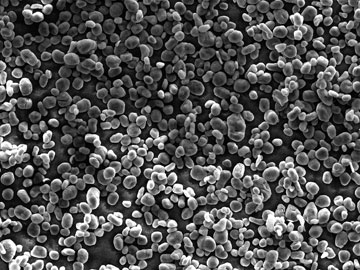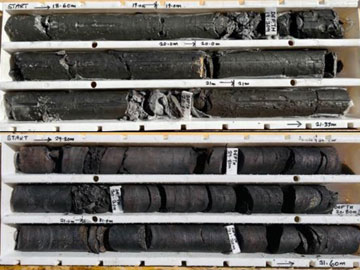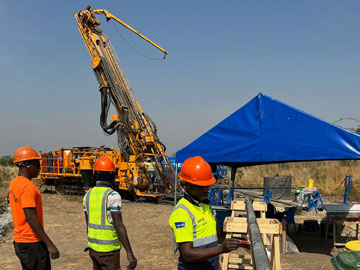Kambale Graphite Project

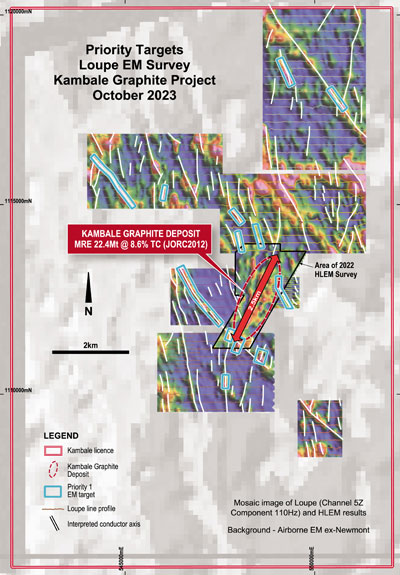
Castle’s Kambale graphite project just keeps delivering:
- March 2024: Successful Battery Anode Tests – Electrochemical test work confirms Kambale natural flake graphite is suitable for use in manufacture of lithium-ion and other battery formats, with a range of key charging, stability and other performance benchmarks achieved.
- February 2024: Outstanding purification results showing purification of 99.97% TGC which exceeds industry benchmark for use in EV battery anode manufacture and confirming no impurities of concern. Prior micronisation and spheronisation processes also successfully completed.
- During the April 2023 MRE work, a large portion of mineralisation was unclassified and not included in the MRE, so from May to September 2023, infill drilling was completed confirming continuity and grade. On 23 October 2023 the Company announced the Maiden JORC Code (2012) MRE had increased by 38% to 22.4Mt at 8.6% TGC containing 1.9Mt of graphite (ASX release dated 23 October 2023).
Castle Managing Director, Stephen Stone commented:
“We are extremely pleased that recently completed electrochemical tests have confirmed Kambale graphite’s status as a very attractive base for the manufacture of lithium-ion electric vehicle battery anodes and a range of other high-value primary and secondary applications.
Purified Kambale graphite met a range of chargeability, stability and other critical performance benchmarks during tests undertaken in an accredited facility in Germany.
In rapid succession Castle has defined a 22.4 million tonne resource grading a very respectable 8.6% TGC and shown it can be upgraded into a valuable 95% LOI graphite concentrate using a conventional flowsheet.
In February this year Castle reported that it had successfully purified this concentrate to an above industry specification of 99.97% LOI, again using a conventional process.
This is all happening at a time when the world needs considerably more fine natural flake graphite to underpin forecasts of very strong growth in the uptake of electric vehicles.
Recent third party offtake deals between non-Chinese upstream producers of primary natural graphite concentrate and downstream manufacturers of natural graphite conductive additives for anodes, cathodes and other secondary battery chemistries are evidence of a paradigm shift in markets away from a high dependency on China supply.
The USA and EU have established billion dollar initiatives to help establish independent supply chains of critical minerals such as graphite. Kambale would therefore be ideally timed and well placed to service both existing and also these new emerging markets.
Recent meetings with the Ghana government confirmed its strong support for any development at Kambale as part of a broader ambition it has to establish West Africa’s first critical minerals hub.
Castle’s view remains that the graphite market is fundamentally very robust and graphite is definitely a commodity to watch this year and into the longer term.”
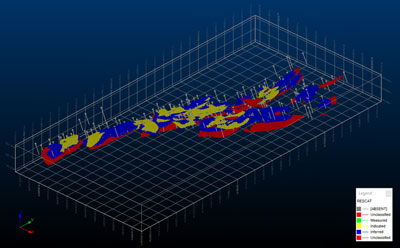


Mineral Resource Estimate (JORC 2012)
| Classification | Tonnes (kt) | Contained TGC (kt) | TGC (%) |
|---|---|---|---|
| Indicated | 9,556 | 843 | 8.8% |
| Inferred | 12,872 | 1,096 | 8.5% |
| Total | 22,438 | 1,939 | 8.6% |
|
5% TGC Cut-Off. TGC = Total Graphitic Carbon For full details, see ASX release dated 23 October 2023 |
|||
Castle Managing Director, Stephen Stone commented:
“We are delighted to deliver for the fast-emerging Kambale Graphite Project a 38% increase in contained graphite and can now boast a Mineral Resource Estimate of 22.4 million tonnes grading 8.6% TGC containing 1.94 million tonnes of graphite. Forty-three percent of the MRE is in the higher confidence Indicated Resource category.
The MRE increase provides a very solid platform upon which to advance our development ambitions, especially now that Castle has demonstrated in test work that a fine flake graphite concentrate of commercial specifications can be produced using a conventional flotation process. This is the primary material used in the manufacture of lithium-ion battery anodes.
This all comes just as China this week has introduced a surprise ban on natural and synthetic graphite exports to protect its battery and car manufacturing industries. This will immediately intensify the multi-billion dollar rush by the USA, EU and other non-China EV manufacturing nations to secure other sources of graphite, battery anodes and EV batteries which they are presently almost totally reliant on China for.
The accelerating take-up of EVs alone is driving an enormous increase in demand for graphite for use in lithium-ion batteries for EVs, power storage units and other chargeable consumer devices.
Each EV contains between 30kg and 60kg of battery grade graphite where every kg of that is derived from at least 3kg of natural flake concentrate.
With another 100 million light EVs forecast to be on the road by 2030, it’s no surprise that forecasters are predicting a natural graphite concentrate supply deficit as current and proposed supply is wholly inadequate.
Castle continues to fast-track and de-risk its Kambale Graphite Project and has just kicked off a specialist evaluation in Germany of the concentrate to confirm its suitability for the manufacture of lithium-ion batteries.
Mining and metallurgical engineering groups will be appointed shortly to assess the technical and commercial merits of establishing on-site a commercial-scale mining and processing facility.
With good access to two international ports in Ghana that can service the USA and EU markets, Kambale has a strategic importance as a still uncommitted resource. The Project will also use mainly hydro-generated “green-grid” power. With Ghana recognised as a safe, stable and established mining jurisdiction, this all bodes well for the Project’s future.”
Project Background
Ghana
Ghana has a well-established mining industry including several Tier-1 gold mining operations. It is now Africa’s largest gold producer and the World’s sixth largest. Accordingly, it has a well-trained and very capable workforce supported by an excellent mining services and supply sector. It is a safe and politically stable jurisdiction based on the democratic Westminster system of government.
Logistics, infrastructure and licencing
The Project is located 6km west of the Upper West region capital of Wa which is 400km north, via good sealed roads, of Kumasi. From Kumasi it is approximately 240km south east by rail or road to the international port of Tema, 30km west of the capital Accra, which provides direct access to global export markets.
The Wa region has an excellent infrastructure including a commercial airport only a few kilometres from the Project, numerous well maintained sealed and unsealed roads, plenty of potable water and reliable grid power largely fed with electricity generated by the 400MWh Bui hydroelectric dam. These will all combine to represent a large saving in Project establishment capital costs.
The 149km² Kambale Graphite Project licence is held by 100% owned Ghanaian subsidiary, Kambale Graphite Limited (“KGL”). The Government of Ghana has the right to a 10% free carried interest in all licences and is entitled to a 5% Gross Royalty on production.
Geology
The genesis of the flake graphite in Kambale is believed to be the result of high-grade metamorphism (amphibolite-granulite facies) which has converted trapped amorphous carbon into characteristic fine crystalline layers.
The Kambale graphite deposit was identified in the 1960s by Russian geologists prospecting for manganese. They undertook a limited programme of trenching and shallow drilling.
2012 drilling
Encouraged by firm graphite prices in 2012, Castle undertook three consecutive phases of drilling comprising RAB (251 holes, 5,621m), aircore (89 holes, 2,808m) and reverse circulation (3 holes, 303m). This work confirmed several zones of moderately to steeply dipping, north-east trending graphitic schists hoisted mainly in granodiorites. A JORC Code 2006 MRE was also undertaken.
Castle also undertook a very limited programme of bench-scale test work on RC chips. Thereafter, little work was undertaken until the more recent improvement in graphite prices prompted a re-evaluation of the Project in early-2021.
Phase 1 metallurgical test work
In September 2021 Castle reported that preliminary bench-scale test work by Independent Metallurgical Operations Pty Ltd (IMO), Perth, on sub-optimal near-surface, weathered graphitic schists sourced from trenches yielded encouraging fine flake graphite concentrate grades of up to 96.4% and recoveries of up to 88%. A conventional multiple grind and flotation concentration flowsheet was used. The three composited samples provided for the test work graded 12.56%, 16.09% and 17.16% TGC.
Ground geophysics and follow-up drilling
In March 2022, a ground horizontal loop electromagnetic (HLEM) survey demonstrated a strong correlation between already drill confirmed graphite mineralisation and zones of high conductivity. Several high conductivity zones also extended well outside of drilled areas.
In late 2022, a 52-hole 5,353m RC programme was undertaken to test the interpreted steep dipping, shallow conductive plates derived from the HLEM survey. The results confirmed that the majority of the plates were associated with graphite mineralisation and that the graphite continued to depths of at least 100m.
Maiden MRE
In early-March 2023 Castle reported that robust lenses of graphitic mineralisation containing high-grade zones with excellent continuity had been delineated by a 30-hole, 2,622m RC infill and 4-hole, 365.2m diamond core drilling campaign.
In April 2023 a maiden JORC Code (2012) Mineral Resource Estimate (“MRE”) of 15.6Mt at 9.0% TGC containing 1.41Mt of graphite was provided by independent consultants, Palaris (Australia) Pty Ltd.
The MRE is hosted by sub-parallel, steep to moderately dipping graphitic schist zones. These were delineated using data from the several phases of trenching and drilling which comprised 386-holes for a combined 16,018m of RAB, aircore, RC and diamond core drilling. Of this database, 85 RC and 4 diamond core holes for a total of 8,644m were used in the actual estimation.
Mineralisation commences at or close to surface and has been drill proven to at least 120m depth and most likely even deeper.
Phase 2 test work
A 300kg sample of fresh, unweathered graphitic schist, sourced from the four diamond drill core holes drilled into various representative areas of the deposit, was delivered to IMO in late December 2022. Bench-scale and then pilot plant scale test work used 215kg of the original sample. A commercial specification bulk fine flake concentrate grade of 95.1% TGC was achieved with a recovery of 79% of the graphite to the concentrate.
Micronisation, spheronisation, purification and electrochemical test work.
The bulk fine flake concentrate has successfully undergone micronisation, spheronisation and purification test work at ProGraphite GmbH, Germany. This produced a 99.97% LOI product with no impurities of concern. Subsequent electrochemical test work has indicated that purified (uncoated) material meets a number of key charging and stability benchmark performance markers confirming its suitability to be used in the manufacture of precursor and Battery Anode Material (BAM) across a range of secondary battery chemistries and battery formats.
Loupe EM survey
A Loupe EM ground geophysical survey completed in June 2023 identified a series of targets on the boarder Kambale licence that require evaluation for the presence of additional graphitic schist mineralisation separate from the main Kambale deposit.
MRE Update
An increased JORC Code (2012) Mineral Resource Estimate (“MRE”) of 22.4Mt grading 8.6% TGC containing 1.94Mt of graphite was reported in October 2023. This included 43% in the higher confidence Indicated Mineral Resource category.
| Classification | Tonnes (kt) | Contained TGC (kt) | TGC (%) |
|---|---|---|---|
| Indicated | 9,556 | 843 | 8.8% |
| Inferred | 12,872 | 1,096 | 8.5% |
| Total | 22,438 | 1,939 | 8.6% |
|
5% TGC Cut-Off. TGC = Total Graphitic Carbon |
|||
The MRE update included 43 RC holes drilled in August 2023. Mineralisation has been delineated over 2.3km north-south within a corridor up to 0.5km wide by several phases of trenching and a combined 424-holes for 21,569m of RAB, Aircore, RC and diamond core drilling campaigns. It has also been confirmed to at least 150m below surface where it still remains open. (ASX release dated 23 October 2023)
- March 2024: Successful Battery Anode Tests – Electrochemical test work confirms Kambale natural flake graphite is suitable for use in manufacture of lithium-ion and other battery formats, with a range of key charging, stability and other performance benchmarks achieved.
- February 2024: Outstanding purification results showing purification of 99.97% TGC which exceeds industry benchmark for use in EV battery anode manufacture and confirming no impurities of concern. Prior micronisation and spheronisation processes also successfully completed.
ESG and Social licence
KGL’s key management has some 17 years of successfully operating in Ghana and in particular its Upper West region. It has established a good reputation for its pro-active commitment to community engagement, local employment and training and aims to apply best practise ESG standards.
KGL has ensured that its activities meet the highest expectations in regard to environmental, social and governance (“ESG”) standards. Resources have been directed to ensuring that all activities are undertaken with the prior, free and fully informed consent of impacted communities.
In parallel and critical to establishing any operation at Kambale, Castle has commissioned and commenced an independent Stakeholder Engagement Programme which was scoped following an independent Stakeholder Identification and Assessment Study. These are being conducted consistent with standards, policies and guidelines of the World Bank, International Finance Corporation, International Labour Organisation and other relevant authorities.
Compensation for access and any disruptions caused is provided in close consultation with landowners, Government and other stakeholders. All site disturbances are rehabilitated immediately after use.
KGL will continue to contribute to the improvement of the well-being of its communities. It has already, at the request of the communities, installed fresh water well, pump and storage facilities and is planning to continue with other critical health improvement initiatives.
The Company’s Ghana-based team is 100% Ghanaian. A key aim is to maximise local employment and include where possible 100% of locally sourced content in all aspects of its operations.
Graphite market
The graphite market is diverse across industrial, metallurgical, chemical and specialised areas with each sector requiring reliable long term supplies of graphite concentrates with very specific qualities. Deposit type, size and geometry, flake size, flake shape, grade, impurities, capital and operating costs, ability to be refined, proximity to specific markets, supply logistics, jurisdiction, fiscal regime and many other factors all combine to determine the commercial viability of a particular deposit.
The current medium to long term outlook for the broader natural fine flake concentrate market is one of escalating demand and a looming supply deficit. This is driven in particular by its use in the fast-growing EV battery and stationary power storage sectors. Kambale graphite is primarily fine flake. At present, there is no viable, high-volume substitute for graphite whether that be natural flake or its synthetically manufactured form which involves a considerably more costly and higher CO₂ generating process. Given the wide variety of uses and required specifications and volumes, the market and pricing for graphite is very opaque.

